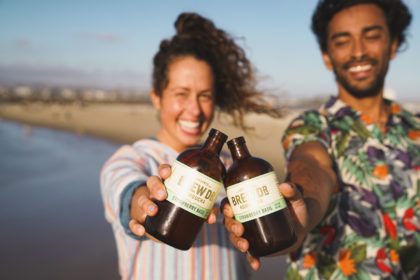
During a year of dramatically changing consumer grocery-shopping patterns, kombucha sales are continuing to grow, but at a slower pace. U.S. retail sales of kombucha sales grew 2.4% over the twelve months though mid-July 2020, to $703.2 million. But this growth rate compares to 9.8% in the prior 12-month period.
Distribution remains strong in conventional stores (up 5.1%), but is decreasing in kombucha’s core, natural stores (down 6.1%).
“This is a piece that’s one to watch and one to manage because it’s one of the better indicators of category health,” says Perteet Spencer, vice president of Strategic Solutions for SPINS (retail data provider). Spencer shared the stats at KombuchaKon 2020. The natural channel, Spencer explained, is where consumer shopping trends emerge.
As grab-and-go shopping and restaurant dining declined during the COVID-19 pandemic, so did kombucha sales. “COVID has hurt,” says Spencer, “but I expect this category will certainly rebound.”
KKon 2020, organized by Kombucha Brewers International (KBI), was a virtual event this year after KBI’s annual in-person KKon in April was cancelled due to the coronavirus outbreak. Hundreds of kombucha professionals from all over the world joined digitally for the two-day conference.
Six months into the coronavirus outbreak and more consumers are purchasing health products. Hannah Crum, KBI president, says education in the kombucha industry is more important than ever as consumers seek health drink options.
“I think this is a really vital opportunity for us as fermentationists,” says Crum. “This is teaching us that health is paramount…this is where kombucha’s opportunity thrives.”
The conference marks the first time industry leaders have met since KBI announced their new kombucha Code of Practice, the first set of safety and quality standards for the industry.
Kombucha has infiltrated mainstream retail, with 83% of stores selling kombucha in some form — a statistic Spencer said is especially impressive. “Rarely do we see full saturation of categories,” she adds. “Certainly there’s room to expand there.”
The retail category SPINS tracks represents sales of refrigerated kombucha and fermented beverages. Kombucha is competing with other adjacent fermented drinks, like cider, functional juices, teas, kvass, vinegar drinks and coffee/cold brew. Kombucha still dominates, representing nearly 90% of the category sales.
The entire beverage industry is a $122 billion market, comprising 16 categories, with soda and carbonated beverages the largest portion ($30.3 billion). Categories with the highest growth rates include plant-based milk (13.4%), creams and creamers (11.1%) and performance beverages (8.9%).
“As you can see, it’s incredibly crowded,” Spencer says. “We’re seeing beverages are playing a lot of different roles. This is important because the consumer data would suggest that consumers are not buying one beverage type.” For example, she says a consumer may want a protein drink in the morning, a yerba mate in the mid-day for a boost, then a kombucha at the end of the day.
“We are seeing the rise of new digestive health benefits and formats really gaining traction, as kombucha and its derivatives scale mainstream,” Spencer says.
Consumers are looking for diverse, nutrient-rich ingredients and flavors. Wellness-focused brands with clean ingredients and holistic ideals are “the engine of growth for the natural products industry…the future is bright for these spaces.” Spencer notes “90% of kombucha brands live and shine in this space.”
The top-selling kombucha flavors in the natural channel include mixed fruit, pineapple and coconut. In the conventional channel, top flavors are ginger, berry and mixed fruit. Top-selling brands are: GT Kombucha, Kevita, Health Ade, Brew Dr. and Humm.
Hard kombucha brands also thrived in the past year. Prime examples are: Boochcraft ($8.6 million in sales, 72.6% growth), June Shine ($6.1 million, 211.2%) and Flying Embers ($3.5 million, 1,398.1%).
Spencer says another major opportunity for kombucha brands is selling larger-size growlers. The 48-ounce size growler is the second-fastest-growing kombucha size. Shoppers are shifting to purchasing larger sizes as they stock up during the pandemic.
“This is such a resilient industry,” Spencer says. “What an incredible opportunity to move with your consumers as they embrace the fundamentals of what kombucha delivers, but also experience it in slightly different ways. People are looking for new experiences and a sense of escape, and so I think (kombucha) brands are uniquely positioned to enter that conversation.”
